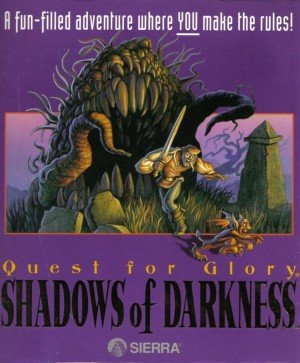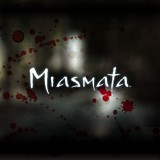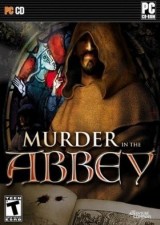Review for Quest for Glory IV: Shadows of Darkness

In any series, even one whose episodes are time and again impressive in most respects, there is usually a single title that stands out above the rest. For me, the highlight of Sierra's Quest for Glory series is the fourth game, Shadows of Darkness. In several important ways it transcends the limits of earlier QFG games, most notably in terms of drama and storytelling.
That Shadows is different from other QFG titles is clear from the very beginning. In the previous three games you arrived in a town with a clear idea of what was going on and a straightforward goal: take care of whatever troubles the country and be proclaimed a Hero. Shadows opens with a bit of mystery in a dark cave, without offering a clue of where you are and whose spell it was that brought you here.
After you escape the cave through a series of puzzles and visit the nearby town of Mordavia, it becomes clear that it certainly wasn't the locals who desired your presence in the Eastern-European valley. The townspeople are very distrustful of strangers and do their best to make you feel unwelcome in their midst. The fact that you came from the cave seems to add even more to their suspicions. Something bad appears to have happened there years ago that brought the valley distress and sorrow.
Despite their unfriendliness, you learn that rumours and fears abound among the villagers. Vampires, werewolves, ghosts, dark magic, undead monsters; the townspeople are afraid and superstitious about so many bogeymen from Slavic mythology that you won't know what to believe -- or what to expect. Something bad is obviously going on in Mordavia, but what exactly you’re up against remains unspoken. Shadows does not give easy answers and unfolds itself as a mystery game that carefully reveals its secrets all throughout the game. This is a welcome narrative improvement, especially compared to QFG3, where most of the plot was revealed during the introduction sequence.
Following standard adventure game customs, you explore the Slavic countryside and get acquainted with the land and its inhabitants. Eventually the opportunity will arise for the ever-aspiring Hero to do his job, as the town’s half-wit gravedigger needs to be rescued. This small act of compassion sets things in motion as the villagers start to realize that they might have judged you wrong.
This doesn't mean that everyone in Mordavia all of a sudden becomes friendly towards you. In fact, the suspicions remain but as you continue your adventures in the valley, the people in town will steadily become more open and warm. This is reflected in how the various characters greet and respond to you. The sheriff, for example, would rather see you leave sooner than later during the first few days that you are in town. He'll slowly turn around over the course of the game and in the end may even call you his friend. Such subtle changes are not only realistic, they also represent a rewarding process of character development.
In addition to the increased character depth, the town's problems are also much more intricate this time around. In previous games, the quests revolved around a certain antagonist that had to be defeated or recovering certain items. In Shadows, the challenges are much more about the characters themselves and their personal troubles. You'll find yourself solving marital disputes and restoring a man's family honour, for example. These objectives let you get much more involved with the characters than you would by solving mundane quests.
The change in focus is reflected by the dialogue system, which is more complex than in previous games. Characters are no longer limited to a single dialogue tree but now have more diverse conversation options, mostly based on recent events and the attitude that the villagers have towards you. Also, QFG4 moves away from the small dialogue portraits seen in most Sierra games of the time and instead uses full screen images that not only show characters' heads but also their upper bodies. Small animations, such as wriggling hands and moving eyes, add a bit of extra detail to these portraits.
Unfortunately, the event-triggered dialogue system can cause some confusion when two or more things happen on a single day. For example, one event caused the death of a certain character, while on the same day I went on a quest unrelated to the character's death that required me to set a building on fire. The next day, the town's gossip was about the first character's death. Not until the day after did the gossip turn to the burned down building, which was a bit odd since it had happened two days earlier.
Shadows' rich characters are brought even more to life in the CD-ROM version which was released after the original floppy version. There is a lot of narrator dialogue that is wonderfully voiced by John Rhys-Davies (of Indiana Jones and Lord of the Rings fame) whose deep voice is spot-on for the game's dark ambiance. Most of the other voice actors also do a fine job as they act convincingly and add flavour with Slavic accents where appropriate.
Unfortunately, the voice acting also introduces some sloppiness that mars the overall impression a bit, such as when the actors interpret their sentences the wrong way. On a few rare occasions, characters speak lines that should have been voiced by the narrator and vice versa. There is also one character for whom some lines appear to be voiced by different actresses. When playing the game with voices as well as the original subtitles, you'll notice that the actors sometimes appear to have taken artistic liberties by adding humorous lines of their own or slightly altering the order of their words. Despite its inconsistencies, however, the voice work is a quality addition that enhances the QFG4 experience.
The other half of the audio department, the game's music, is also vital to the atmosphere. There are basically two themes that can be discerned throughout the game. One is a metal/rock style that represents the game's horror theme. It is heard in shadowy places and during combat, and it's mostly dark and brooding, which greatly adds to Shadows feeling scary. The other theme is more warm and comfortable, and is played in the town and other places of safety in Mordavia. There are some beautiful classical compositions, and the inn’s background music is a borrowed piece from well-known composer Edvard Grieg, which flawlessly blends in with the rest of the score.
The visuals are less colourful here than in QFG3, appropriately for a game with a darker theme set in Eastern Europe. Still, the graphics are good looking in their own right, especially because of the lush detail. Background images and character portraits are hand drawn and presented in 256-colour VGA. QFG4 doesn’t stand out when it comes to animation, but rarely are character sprites ever seen standing lifelessly still. There are also some nice extra touches, such as the sheriff closing the windows of his office at dusk.
The detailed graphics make travelling around the valley a worthwhile experience, and the variety of locations ensures there are lots of places to visit and things to do. One of the complaints with QFG3 was that the land was too empty, which gave that game an unexciting and lonely feeling. In Shadows you’ll find places of interest just around every corner, not only providing people to interact with but puzzles as well. One moment you’ll find yourself in a dark swamp which can only be traversed through strength, acrobatics or magic, while the next you'll be visiting a camp of gypsies who add flavour to this land otherwise filled with sombre people.
There are also some daily occurrences to be discovered in the valley. The gypsy fortune teller, for example, will read your future through tarot cards once each day, while resting in certain places triggers dreams that tell a continuing story each night. These are interesting extras, but it's likely the game will end before you're able to witness all these bonus events.
As a typical QFG game, the focus still isn’t on puzzles as much as traditional adventure games, and the puzzles that are available commonly revolve around the use and training of your skills, such as throwing and picking locks. However, there are more inventory puzzles this time, although you can't approach each and every obstacle expecting to solve it with your items. But because it is uncertain whether your inventory holds a solution, you’ll be encouraged to deal with each situation with a more open mind instead of constantly reaching for every object in your possession.
There are also some mini puzzle games in QFG4, such as jigsaw puzzles and memory games, most of which are essential to completing the game. These puzzles aren’t very difficult, especially when the difficulty setting is turned down, which simplifies the challenge at the expense of the bonus reward to your intelligence skill. The difficulty can be adjusted at all times in the options menu, and those that are still frustrated by the puzzles can also freely get help by clicking on the hint button. Repeatedly asking for hints may even lead to some solutions being given away completely.
All movement and interaction is done through Sierra’s now-familiar point-and-click interface. Different icons can be selected to walk around and interact with the surroundings. Additional sub-menus display icons used for skills, spells and accessing the character sheet. Shadows also introduces a small status bar on top of the screen that shows how much health, stamina and magic points you have left, so you no longer have to go looking for it on your character sheet.
Like the earlier QFG games, various puzzles can once again be solved differently by each of the character classes, Fighter, Wizard, Thief and Paladin, depending on their individual abilities. Each also has one or more sidequests available only for their class. The Fighter class is again a watered-down version of the exclusive and much more interesting Paladin class, which can only be played if imported from one of the previous games. The Paladin gets a couple of extras, such as two sidequests, which makes it regrettable that it is not possible to obtain Paladinhood in this game.
Quest for Peace? Part 4
Once again I investigate how much the game depends on combat and action, and whether it's possible to minimize and even eliminate these elements if so desired. My philosophy is that the QFG games are only as combat-heavy as you like them to be, but in Shadows of Darkness there are some combat scenes which are unavoidable, even for Wizards and Thieves. Unavoidable for the Hero, that is, though not necessarily for the player as you can let the computer do the fighting for you.
I did find that I was less likely to encounter random monsters while travelling through the valley of Mordavia. Also, because the valley is relatively compact and holds many places where monsters won’t follow you, it is not difficult to avoid or run away from any random encounters. Those who have the Magic skill may eventually even learn a spell of hiding that causes monsters to leave immediately.
Another solution is to set the game’s difficulty to easy and turn on the strategy option, which lets the computer’s A.I. run all battles for you. Even the tougher obligatory battles should be possible to overcome this way. This option is least attractive for Thieves, who are slower to finish such battles due to their limited combat strength. Those who truly wish to abstain from each and every action sequence but don’t mind sitting through an automated battle now and then are advised to play as a Fighter or Paladin character. Paladins that can cast spells have the best resources to end combat quickly effectively. Wizards are a viable option too, but they are required to complete two obligatory action sequences that don’t take place in the combat screen and thus can’t be automated.
Another typical element of the QFG games is the presence of random wandering monsters and combat. In Shadows, however, the combat system has been completely overhauled. The previous three games showed the Hero from behind, facing his opponent. There were some strategic options, but since these usually didn’t work very well, the best option was simply to continually strike at the enemy. QFG4 uses a more action-arcade style combat shown from the side, which allows you to move closer to and away from adversaries. Defence and dodge options can be used more effectively, and there are options like employing distance attacks by throwing daggers, casting spells and a even a special combo for Heroes with the acrobatics skill. The Hero isn't the only one to receive a combat upgrade in this game, mind you. Previously the difference between various monsters had been nothing more than some being stronger than others. Now, monsters use their own tactics: some are fast and aggressive, while others cast spells and will try to keep you at a safe distance.
While these tactical improvements make combat an actual challenge, it may not be for everyone since the controls aren’t easy to use and are even more difficult to master. Fortunately, players that either don’t care about combat or dealing with the controls can make use of the strategic setting, which lets the game control combat for you. This won’t grant you automatic victory, but since the artificial intelligence is very adept at combat you will only lose to those enemies whose skills really are a notch above your Hero’s. This strategic setting also lets you adjust the balance between aggressiveness, defence, magic use and special attack for tactical fine-tuning. When combined with the difficulty set to easy, then, the arcade-style combat shouldn’t be a nuisance to those that dislike fighting. As long as you don’t neglect to train your skills, which will also continue to improve when combat is automated, you’ll be able to play through QFG4 without doing combat yourself if you so desire.
Enemies aren't the only obstacles you'll need to contend with, but the other type is technical in nature. The game's original release was rushed for Christmas but was so loaded with bugs that many gamers were unable to complete it. Some of these bugs were dealt with in patches released by Sierra, but not all of them, and today’s faster computers now cause some fatal speed errors to occur. Most of these issues should be resolved when using DOSBox in combination with helpful fan-made patches.
Even though Shadows is one of the later games in the series, it can be enjoyed as a standalone game. This may have something to do with the fact that QFG4, unlike parts 2, 3 and 5, puts you in an isolated new environment without being accompanied by characters from any of the previous games. On the other hand, the unwelcome attitude of the villagers and the vague nature of the plot early in the game might confuse new players as to what they are supposed to be doing.
While remaining true to the series as part-RPG, the fourth Quest for Glory is even more of an adventure game than its predecessors due to the increased focus on story, characters and puzzle solving. It would be regrettable if people were to miss out on a wonderful adventure game because of its hybrid nature. Shadows of Darkness might take some time to get used to due to its dark mystery theme, but once you really get into this game it becomes an intriguing experience that will keep you excited all the way up to the dramatic finale.

































